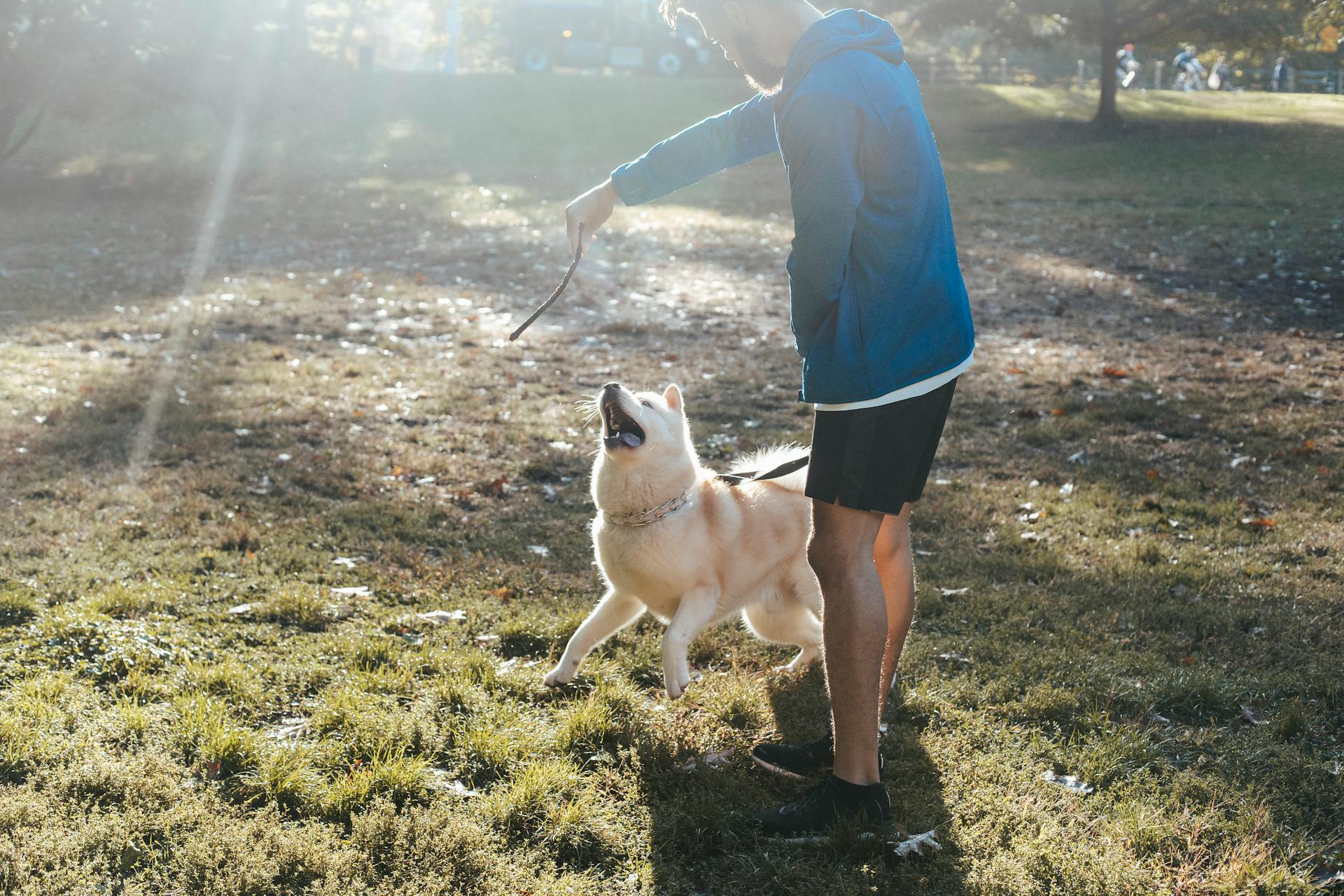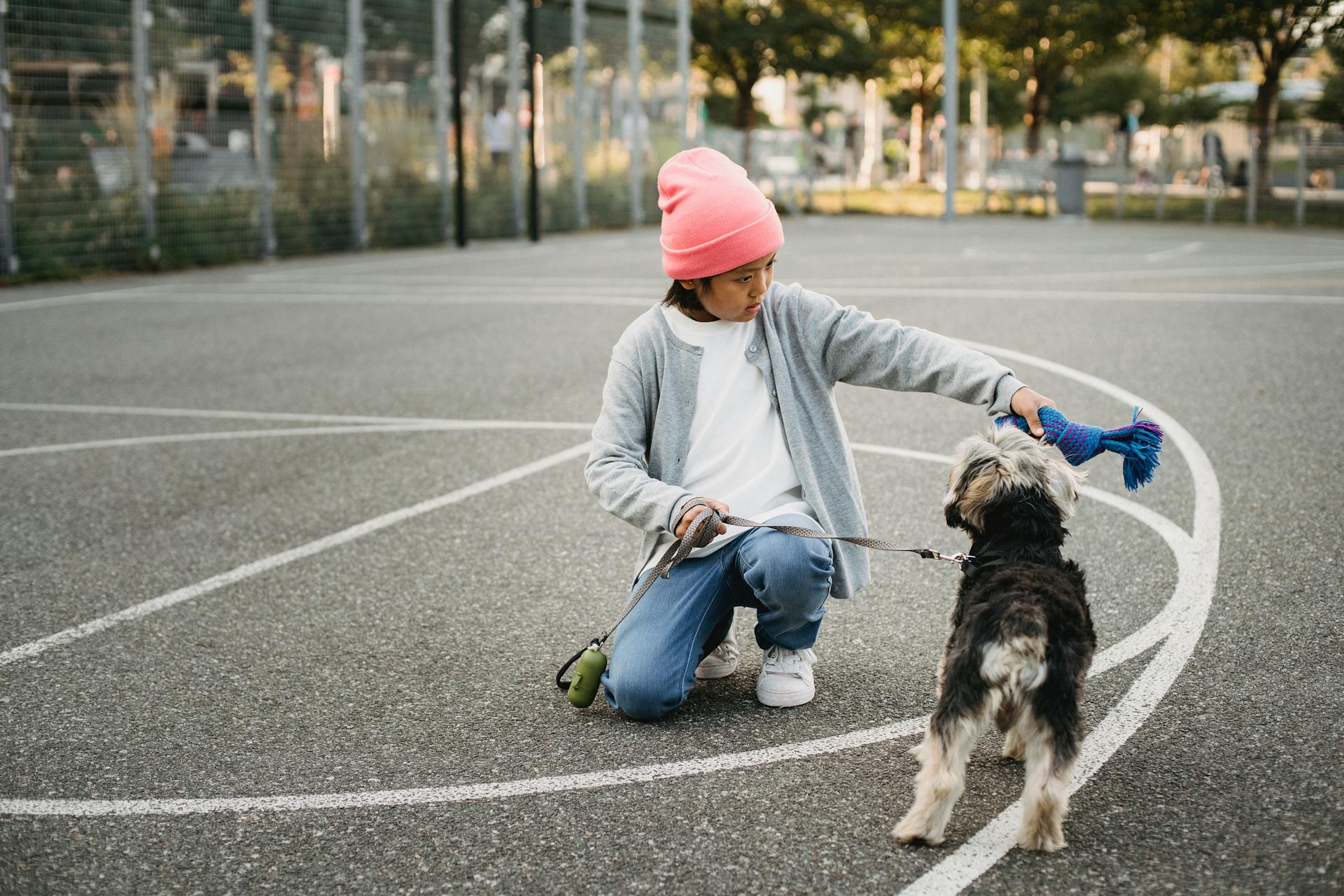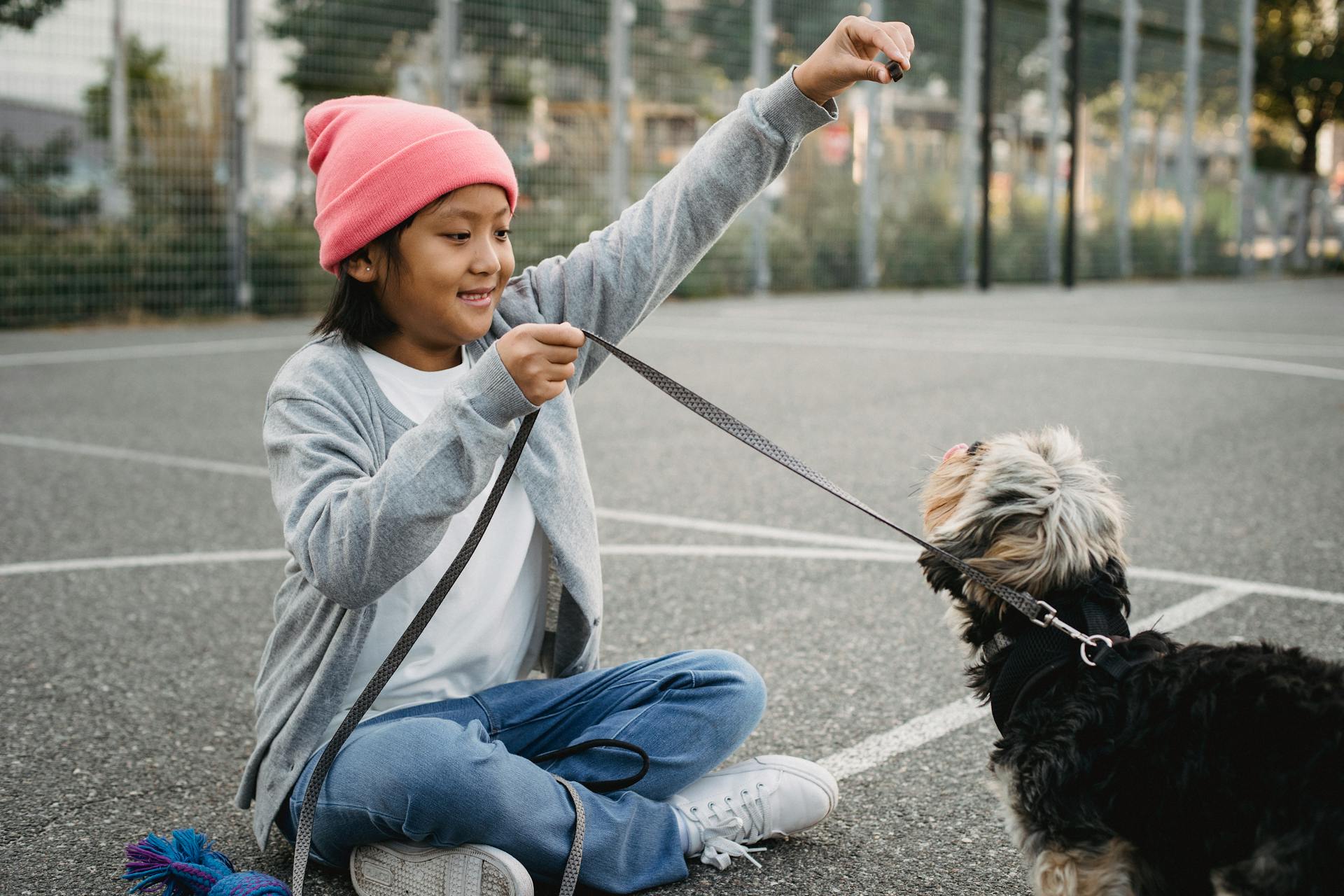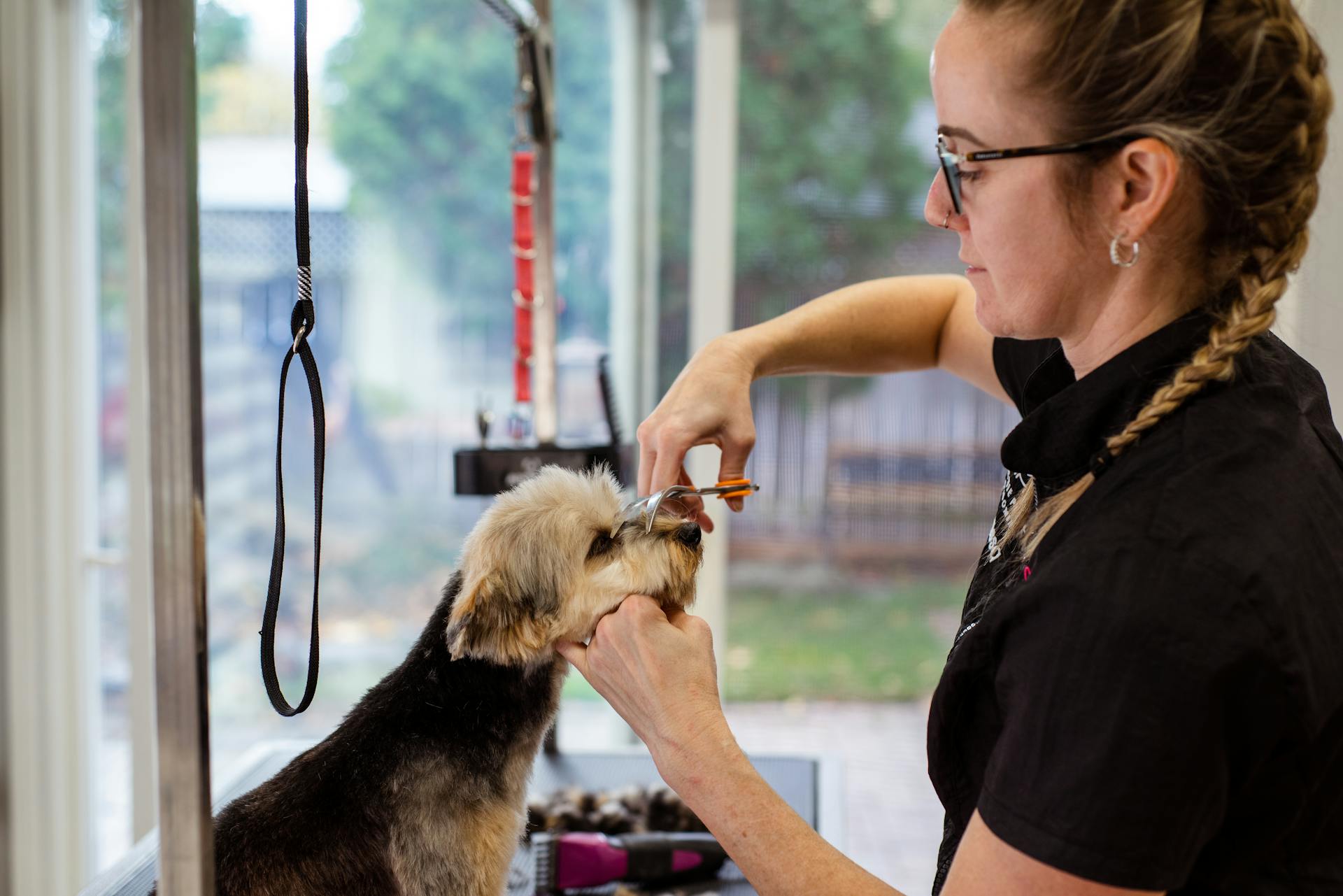
Training your dog to stay is a fundamental skill that requires patience, consistency, and positive reinforcement. Start by choosing a quiet and distraction-free area with your dog on a leash.
The ideal distance for practicing the "stay" command is 5-10 feet away from your dog, as this allows them to feel comfortable and focused.
To begin, have your dog sit or lie down, then take a few steps back while saying "stay" in a calm and clear voice.
Preparation
Puppies can start learning the stay command as early as eight weeks old, making them a great candidate for training.
Consistency is key when teaching a dog to stay. To reinforce the behavior, use a clear and confident voice command and reward the dog immediately with the chosen incentive, such as treats, praise, petting, or playtime.
Short, engaging training sessions are suitable for a puppy's developing attention span.
Define Your Criteria
Defining your stay criteria is a crucial step in teaching your dog this valuable command. It's essential to know exactly what you expect from your dog in terms of duration, distance, and distractions.

The general definition of stay is that a dog will hold a stationary position until they are asked to do something else or given permission to move about. This means you're simply extending the length of their Sit, Down, or Stand training cue.
To gauge progress and adjust your training pace, think about what your criteria will be for your dog's stay cue. Consider the position you usually ask your dog to stay in, such as Sit, Down, or Stand.
A relaxed Down position often allows dogs to hold a longer duration of stay. The length of time you expect your dog to stay in position can vary from 10 seconds to 30 minutes, depending on the situation.
The distance between you and your dog when they're holding their stay is also important. You may need to be close by, like when walking to the front door, or farther away, like when going out of your dog's sight.
Here's a breakdown of what to consider:
- Position: Sit, Down, or Stand?
- Duration: 10 seconds to 30 minutes?
- Distance: Close by or out of sight?
- Distractors: At home or in a busy cafe?
By defining your stay criteria, you'll be able to tailor your training to your dog's needs and achieve the desired results.
What You'll Need:

To prepare for training, you'll need a few essential items. A dog who has a basic understanding of Sit, Down, or Stand behavior on verbal cue is a must.
You'll also need a long training leash for practicing outside of your home or securely fenced area. This will give your dog the freedom to move around while still keeping them safe.
A training treat pouch is a game-changer for keeping your treats organized and within reach. My favorite is the Voilà Ultimate Treat Pouch, which is made of high-grade silicone and easy to wash.
You'll need a clicker or a marker word like "yes!" to mark the exact moment your dog performs the desired behavior. This helps them associate the sound or word with the action.
A supply of your dog's favorite training treats is also necessary. Some great options include Zuke's Mini Natural training treats, low-fat string cheese, or turkey hotdogs cut up into tiny pieces.
On a similar theme: Dog Treat Training
Benefits of Teaching

Preparation is key to a harmonious home life with your dog. Teaching your dog to go to their designated place can be a lifesaver in tight spaces such as the kitchen or living room.
Having a designated place for your dog to go to can prevent accidents when handling hot pans or opening the oven. This is especially important in the kitchen where hot pans and sharp objects are often used.
Teaching your dog to stay in their place can also give you peace of mind when you're entertaining guests or having a dinner party. You'll be able to move around your dog with ease and confidence.
Related reading: When to Start Dog Training Classes
Training Basics
To train a dog to stay, you'll need a clear and consistent command, like "stay", and to start with short periods of staying before gradually increasing the duration. Consistency is key, so use the same cue every time.
The stay command is essential in dog training, serving as an exercise in self-control and discipline for the dog. It involves instructing the dog to remain in a specified position despite distractions.
To build a solid foundation for the stay command, practice adding duration to a behavior first, starting with short periods like one to three seconds and gradually increasing to 45 seconds to one minute. This will help your dog understand that holding the position makes the treat happen.
Recommended read: Dog Training Position Box
Teaching Basics
You can start teaching your dog the stay command as early as eight weeks old, but it's essential to keep training sessions short and engaging for their developing attention spans. Puppies can learn quickly, but consistency is key.
To establish a strong stay cue, use positive reinforcement, rewarding your dog with training treats and praise to encourage compliance and make the training process enjoyable for them. Consistency is key, so use the same cue every time.
The "stay" command is essential in dog training, serving as an exercise in self-control and discipline for the dog. It involves instructing the dog to remain in a specified position—such as sitting, standing, or lying down—despite distractions.
To begin with, choose a specific hand motion and verbal command to signify the "Stay" cue. Start by having your dog in a sit or down position, give the stay cue with a firm hand gesture and a clear, calm command like "Stay."
A different take: Why Use a Clicker for Dog Training
To build duration, start with short periods, like a few seconds, before rewarding your dog. As they begin to understand, gradually increase the duration they are asked to stay. Always reward them afterwards to reinforce the behavior.
For a reliable stay command, many dogs can learn it within a few weeks with daily sessions. Consistency and gradually increasing the duration and distractions are crucial for the dog to master the command.
Getting on
Getting on the mat is a great place to start your training journey with your dog. Place the mat on the floor and wait for your dog to move towards it.
Mark 'Yes' and reward your dog with a few treats on the mat as soon as they approach it. This positive reinforcement will help them associate the mat with good things.
Does your dog continue to move back towards the mat after each reset? If they do, you're on the right track.
On a similar theme: Dog Mat Training
Training the Command
To establish a strong "stay" command, use positive reinforcement, rewarding your dog with training treats and praise to encourage compliance and make the training process enjoyable for them.
The "stay" command is essential in dog training, serving as an exercise in self-control and discipline for the dog. It involves instructing the dog to remain in a specified position—such as sitting, standing, or lying down—despite distractions.
A clear and consistent command, such as "stay", is crucial for effective training. This command should always be communicated in a calm and clear tone.
You can start by having your dog stay for short periods, and then gradually increase the duration. This will help them learn to maintain the stay command reliably, no matter the situation.
Proofing the stay command involves training your dog to stay under various conditions with increasing levels of distractions. This step requires patience and may take more time, but it's essential for the dog to learn to stay reliably, no matter what's going on around them.
By rewarding your dog with positive reinforcement when they obey the command, you'll make the training process enjoyable for them and encourage compliance.
Curious to learn more? Check out: Dog Training with Distractions
Rewarding Properly
Rewarding your dog properly is crucial to reinforce the stay command. Immediate positive reinforcement is necessary when your dog successfully remains in the stay position.
The timing of the treat and praise is crucial; it should follow the behavior quickly so the dog can make the correct association. Verbal affirmations like "good stay" and physical rewards such as dog treats or a favorite toy are effective ways to reward your dog.
A bonus tip is to reward your dog immediately after they remain in the stay position, as this helps them associate the behavior with the reward.
Worth a look: Reward Based Dog Training
Advanced Training
As you progress in training your dog to stay, it's time to take their skills to the next level with advanced training. The goal is to help your dog maintain the stay command in distracting environments, which is crucial for their overall training.
Mastery of the down-stay, especially in distracting environments like backyards, is pivotal. This means practicing the stay command in areas with minimal distractions and gradually increasing the level of distractions.
Curious to learn more? Check out: Next Level Dog Training
A dog's ability to obey the stay command in a quiet room is just the beginning. For advanced training, you'll want to introduce distractions in a controlled environment, starting with minimal ones. Here are some examples of distractions you can introduce:
- Moving toys or rolling balls
- Other people walking around or jogging past
Practice the stay command in these environments, rewarding your dog for staying put despite temptations. Placing your dog in a lie down position before giving the stay command can promote calmness and stability.
Once your dog has mastered the basic stay command, you can introduce new challenges to strengthen the behavior. This can include noises or movement while your dog is in a stay. Using a collar and leash during this process can improve safety and control, ensuring your dog feels secure amidst these controlled distractions.
Safety and Control
Safety and control are crucial when training your dog to stay. Use a leash in all training scenarios until your dog exhibits a strong and reliable stay.
Patience is key, and a controlled environment is ideal for practice. This allows your dog to focus and learn the stay command effectively.
Safety always comes first, and you should be prepared to correct your dog with gentle guidance if they break the stay.
Age and Development
Puppies can start learning the stay command as early as eight weeks old. Short, engaging training sessions are suitable for their developing attention spans.
At eight weeks old, puppies are still learning to focus and may have short attention spans, so training sessions should be brief and fun. Consistency is key to teaching a puppy the stay command.
To master the stay command, consistent practice and supervision are essential. This means setting aside time each day to work with your puppy and rewarding them for good behavior.
Many dogs can learn a reliable stay command within a few weeks with daily sessions.
Take a look at this: Dog Training 8 Weeks
Tips and Setup
To start, it's essential to create a comfortable environment for your dog to learn. Place a mat next to you while doing other activities, like sitting watching TV, to make training easy and convenient.
Having treats on hand is crucial to reward your dog for staying in the down position. Vary the length of time between treat drops to keep your dog engaged and motivated.
If your dog gets up after being fed or marking 'Yes', go back to the mat and ask them to lay down, then reward them by placing food on the mat. This ensures your dog understands that staying in position on the mat is worthwhile.
To practice settle on a mat in different locations, start by placing the mat in the kitchen and cue 'Settle'. This will help your dog get used to staying in position in a variety of environments.
As you progress to new places, begin with simple distractions and make it easy for your dog before increasing the challenge. This will help your dog build confidence and learn to stay in position even in new and distracting environments.
A fresh viewpoint: Dog Diaper Training
Sources
- https://www.preventivevet.com/dogs/how-to-teach-your-dog-to-stay
- https://roguepetscience.com/blogs/dog-training/how-to-teach-a-dog-stay
- https://www.dogtra.com/blog-and-events/teach-your-dog-stay-command
- https://www.nylabone.com/dog101/how-to-teach-your-dog-to-sit-and-stay
- https://caninelearningacademy.com/dog-settle-mat-calm/
Featured Images: pexels.com


